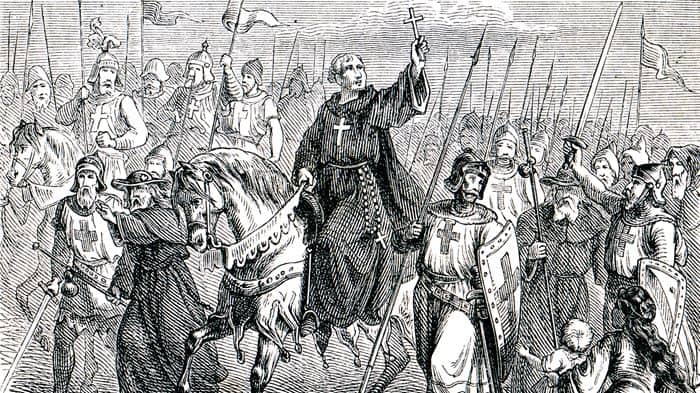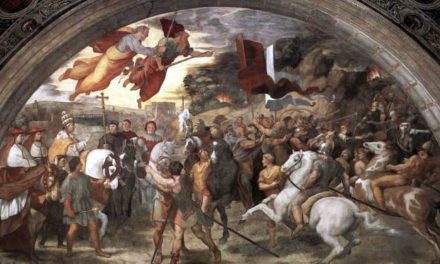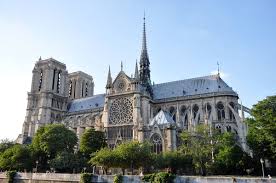Episode 54 – The Crusades – Part 1
In the first episode of Communio Sanctorum, we took a look at the various ways history has been studied over time. In the Ancient world, history was more often than not, propaganda. The old adage that “History is written by the winners” was certainly true for the ancients. With the implementation of the Scientific Method in the Modern Era, the researching and recording of history became more unbiased and accurate. It was far from a pure report, but it could no longer be considered blatant propaganda. The Post-Modern Era has seen a return to bias; this time an almost knee-jerk suspicion of ALL previous attempts at recording history. Even attempts of Modernity to document history are suspect and assumed guilty of recording little more than the bias of the authors, though their works were footnoted and peer-reviewed. Post-modern critics adopt a presupposition all recorded history is fabrication, especially if there’s anything heroic or virtuous. If it’s a dark tale of hopelessness and tragedy, well, then, maybe it can be accepted. It’s almost as though Post-moderns want to make up for the ancient historians’ penchant for propaganda. Post-Moderns cast history as “neg-paganda” if I can coin a word.
Let’s attempt a shedding of our bias, even though we can’t fully do that, as we look at the Crusades. Instead of layering onto the Christians of Europe in the 11th and 12th Cs the sensibilities of people who live a thousand years later, let’s attempt to understand the reasoning behind the idea of taking up a pitchfork or sword and making a life-altering trip over hundreds of miles, through strange lands, to risk one’s life for è What? Oh yeah, to rid the Holy Land of pagan infidels.
Wait; Mr. Crusader-person; have you ever been to the Holy Land? Do you own land there that’s been stolen? Do you have relatives or friends there you need to protect? Have you ever met one of these infidels? Do you know what they believe or why they invaded?
No? Then why are you so amped about marching half-way around the world to liberate a land you’ve not been all that interested in before from a people you know nothing about?
See? There must have been some powerful forces at work in the minds and hearts of the people of Europe that they’d go in such large numbers on a Crusade. We may find their reasons for crusading to be horribly ill-conceived, but they were totally sold out to them.
The Crusades reflected a new dynamism in the Christianity of Medieval Europe. People were driven by religious fervor, a yearning for adventure, and of course if some personal wealth could be thrown in, all the better. For 200 years, Crusaders tried to expel the Muslims from the Holy Land. It seems all the colorful figures of this era were caught up in the cause, from Peter the Hermit in the 1st Crusade, to the godly Louis IX, King of France, who inspired the 6th and 7th.
Many Europeans of the medieval period viewed a pilgrimage as a form of especially poignant penance. These pilgrimages were usually trips to a local holy place or shrine erected to commemorate a miracle or to cathedrals where the relics of some saint were kept in a reliquary. But there was one pilgrimage that was thought to gain a special dose of grace – a trip to the Holy City of Jerusalem. The merchants of Jerusalem did a good business in keeping the constant flood of Christian pilgrims supplied with food, lodging and of course sacred mementos. Some pilgrims went by themselves; others in a group—ancient versions of the modern day Holy Land Tour. When pilgrims arrived in Jerusalem they’d make the rounds of all the traditional points of interest. They walked the Via Dolorosa to Calvary then sat for hours praying. When these pilgrims returned home, they were esteemed by their community as real saints; towering figures of spirituality.
For centuries, peaceful pilgrims traveled from Europe to Palestine. The arrival of Islam in the Middle East in the 7th C didn’t interfere. By the 10th C European bishops organized mass pilgrimages to the Holy Land. The largest we know of set out from Germany in 1065, with some 7,000 ! That’s a lot of buses.
To impede a pilgrim’s journey was considered by the medieval Church as a serious breach of protocol because you endangered the pilgrim’s salvation. If his pilgrimage was penance for some sin, you might deny him pardon by your altering his course. The mind-set of European Christians became one of extreme care to not interfere with Pilgrims once they’d set out.
All of this faced a major problem in the 11th C when a new Muslim force took control of the Middle East. The Seljuk Turks, new and fanatical converts to Islam, came sweeping in to plunder the region. They seized Jerusalem from their fellow Muslims, then moved north into Asia Minor.
The Byzantine Empire tried desperately to stop their advance, but at the Battle of Manzikert in 1071 the Turks captured the eastern emperor and scattered his army. Within a few years nearly all Asia Minor, the chief source of Byzantine wealth and troops, was lost, and the new Byzantine emperor sent frantic appeals to the West for help. He pleaded with Europe’s nobility and the Pope, seeking mercenaries to aid in the rescue of lost territory.
Then, reports began to trickle back about the abuse of Christian pilgrims on the Turkish controlled roads to Jerusalem. The trickle turned to a stream, the a river. Even when pilgrims weren’t mistreated, they were subject to heavy fees to travel thru Muslim lands.
The standard, brief description of the inception of the First Crusade goes like this … In 1095, the Eastern Emperor Alexius I sent an urgent appeal for help against the Muslims to Pope Urban II. The Pope responded by preaching one of history’s most influential sermons. In a field near Clermont, France he said to the huge crowd that had gathered, “Your Eastern brothers have asked for your help. Turks and Arabs have conquered their territories. I, or rather, the Lord begs you, destroy that vile race from their lands!”
But there was more to Urban’s appeal than just liberating the East from infidel hordes. He also mentioned the European need for more land. He said, “For this land which you inhabit is too narrow for your large population; nor does it abound in wealth; and it furnishes scarcely food enough for its cultivators. Hence it is that you murder and devour one another, enter upon the road to the Holy Sepulcher; wrest that land from the wicked race, and subject it to yourselves.”
Popes and bishops were accustomed to making such bold proclamations and issuing stirring appeals. They were nearly always met by loud “Amens!” and affirmations of the rightness of their call. Then people went home to lunch and promptly forgot all about what they’d just heard. So the response to Urban’s sermon that day was astonishing. The crowd began to chant, “Deus vult = God wills it!” But they did more than chant. People across the entire socio-economic spectrum of Europe began preparations to do precisely what the Pope had said è Go to Jerusalem and liberate it from the Muslims. They sewed crosses onto their tunics, painted them on their shields, fired up the smithies and made swords, spears and maces. Commoners who couldn’t afford armor or real weapons, made clubs and sharpened sticks.
They were going to go on a new kind of pilgrimage. Not as humble worshippers but as armed warriors. Their enemy wasn’t the world, the flesh and the devil; it was the Muslim infidel defiling the Holy Places.
As the Pope ended his impassioned appeal to the loud affirmation of the crowd, he declared their slogan Deus Vult! would be the crusader battle cry in the coming campaign.
The pilgrims agreed to make their way east any way they could, gathering at Constantinople. Then they’d form into armies and march south toward the enemy.
The First Crusade was underway.
As word spread across France and Germany of the holy mission, people from across all social levels were caught up in Crusader fervor. A similar excitement was seen in the California and Yukon Gold Rushes. It’s not difficult to understand why. We need to be careful here because removed by a thousand years we can’t presume to know the motivations that shaped every Crusader’s actions, even though there are not a few historians who claim to be able to do so. Surely motives were mixed and diverse. Some, out of simple obedience to the Church and Pope, believed it was God’s will to expel the Muslims from the Holy Land. Being illiterate peasants, they couldn’t read the Bible or know God’s will on the matter. They believed it was the Pope’s duty to tell them what God willed and trusted him to do it. When the Pope declared anyone who died in the holy cause would bypass purgatory and enter directly into heaven, all the incentive needed to go was provided for thousands who lived in the constant fear of ever being good enough to merit heaven.
Another powerful incentive was the opportunity for wealth. Medieval Europe was locked in a rigid feudalism that kept the poor in perpetual poverty. There was simply no rising above the social level one was born into. A Crusade offered a chance at the unthinkable. The loot of a successful campaign could bring great wealth, even to a peasant. And those who returned gained a reputation as a warrior that could see them and their sons raised into positions of relative honor in a noble’s army.
The risks were great; but the benefits both tangible and significant. So thousands took up the crusader cause.
The problem for the thousands of peasants who wanted to go was that no noble would lead them. On the contrary, the nobles wanted their serfs to stay home and tend their fields and farms. But the Pope’s appeal had gone out to all and no noble wanted to be seen as contradicting the Church. So they just hoped no one would rise to lead them. It was one of those moments of profound leadership vacuum that just begged to be filled; who filled it was a man known as Peter the Hermit.
Of all the Crusaders, Peter surely had the strongest scent. The monk had not bathed in decades. He rode a donkey that, eyewitnesses said, bore a remarkable resemblance to its owner. Peter’s preaching was even more powerful than his odor. In 9 months, he gathered 20,000 peasants under his banner, then began the long and difficult trek east to Constantinople.
They created chaos as soon as they arrived. Complaints of robbery poured into the Emperor’s office. He knew these Western European peasants were no match for the Muslims, but he couldn’t let them camp out in his city. They were ferried across the river where they immediately began pillaging the homes of Eastern Christians. Many of these poor, uneducated and illiterate peasants had come for loot and saw plenty of it right there. They’d already travelled a long way from home and were now among a people who spoke a different language, wore different styles and ate different foods. “Why, they don’t look like Christians at all! And what’s that you say? These people don’t follow the Pope? Well, then maybe they aren’t Christians. Didn’t we set out to fight unbelievers? Here are some. Let’s get to work.”
“But these aren’t Muslims!”
“Okay. We’ll compromise. We won’t kill them; we’ll just take their stuff.”
Peter’s peasant army put additional strain on the already poor relations between the Eastern and Roman churches. Two months later, the peasants marched straight into a Muslim ambush and were wiped out. Peter, who was in Constantinople rounding up supplies—was the lone survivor. He then joined another army, this one led by European nobility who arrived well after the peasants. These Crusaders defeated the Muslims at Antioch then continued on to Jerusalem.
The Muslims failed to take this second movement of the Crusade seriously. It’s not difficult to understand why. They’d just defeated a huge force of Europeans easily. They assumed they’d do the same to the smaller force that came against them now. What they didn’t realize was that this force, while indeed smaller, was the cream of Europe’s warrior class; mounted and armored knights who grew up on battle.
On July 15, 1099, Jerusalem fell to the Crusaders. It was a brutal massacre. Around the Temple Mount, blood flowed ankle-deep. Newborn infants were thrown against walls. It wasn’t just Muslims who knew the Crusaders’ wrath. A synagogue was torched, killing the Jews trapped inside. Some of the native Christians were also put to the sword. To this day, the wholesale slaughter of the First Crusade affects how Jews and Muslims perceive the Christian faith.
But — and this in no wise is meant to be a justification for the brutality of the Crusades; it seems just a tad hypocritical for Muslims to decry the atrocities of the Crusades when it was by the very same means they’d laid claim to the holy land in the 7th C. In truth, while crusading under the Christian cross is a horrible violation of the morality of Biblical Christianity—Jihad, Holy War is one of the main tenets of Islam. Long before the Pope erroneously offered absolution to Crusaders and the promise of heaven to those who died in the campaign, Islam promised paradise to Muslims who died in Jihad. Historically, while the Christian faith has spread by the work of humanitarian missionaries, Islam has spread by the sword. Or we might say, while true Christianity expands by the sword of the Spirit, Islam spreads by a sword of steel.
Following the conquest of Jerusalem, the Crusaders carved out four states in the Middle East; the Kingdom of Jerusalem, the County of Tripoli, the Principality of Antioch, and the County of Edessa.
This First crusade was followed by eight more, none of them really able to accomplish the success of the first, if we can call it success. All told, the gains of the Crusades lasted less than 200 years. But one major accomplishment was the reopening of international trade between Europe and the Far East, something that had languished for a few hundred years.
The Crusades have proven to be the focus of much historical study and debate. They’re usually linked to the political and social situation in 11th C Europe, the rise of a reform movement within the papacy, and the political and religious confrontation of Christianity and Islam in the Middle East. The Umayyad Caliphate had conquered Syria, Egypt, and North Africa from the predominantly Christian Byzantine Empire, and Spain from the Arian Christian Visigoths. When the Ummayads collapsed in North Africa, several smaller Muslim kingdoms emerged and attacked Italy in the 9th C. Pisa, Genoa, and Catalonia battled various Muslim kingdoms for control of the Mediterranean.
The Crusaders were emboldened in their prospects for success in the Holy Land because of the successes they’d had in the Reconquista, the conquest of the Muslom Moors in the Iberian Peninsula. Earlier in the 11th C, French knights joined the Spanish in their campaign to retake their homeland. Shortly before the First Crusade, Pope Urban II encouraged the Spanish Christians to reconquer Tarragona, using much of the same symbolism and rhetoric he later used to preach Crusade to the people of Europe.
Western Europe stabilized after the Saxons, Vikings, and Hungarians were brought into the Church by the end of the 10th C. But the demise of the Carolingian Empire gave rise to an entire class of warriors who had little to do but fight among themselves. The incessant warfare sapped Europe of its strength and wealth. Europe needed an external enemy they could turn their wrath on. As we saw in a previous episode, while the violence of knights was regularly condemned by the Church, and there was the attempt to regulate them in the treaties known as the Peace and Truce of God, the knights largely ignored these attempts at pacification. The Church needed an external threat they could direct the knights lust for battle toward.
It was also at this time that the Popes were in constant competition with the Western emperors over the issue of investiture – the question of who had the authority to appoint bishops; the Church or the nobility. In some of the squabbles between Church and State, the popes weren’t above calling out knights and nobles loyal to them to back down the power of the Emperor and recalcitrant nobles. So the Pope’s mobilizing an armed force wasn’t that far out of context.
Another reason Pope Urban called for the First Crusade may have been his desire to assert control over the East. Remember that the Great Schism had occurred 40 years before and the churches had been rent ever since. While historians suggest this as one of several reasons driving Pope Urban’s decision to start the Crusade, there’s no evidence from any of his letters this factored into his plans.
Until the crusaders’ arrival, the Byzantines had continually fought the Muslim Turks for control of Asia Minor and Syria. The Seljuks, Sunni Muslims, had at one time ruled the Great Seljuk Empire, but by the First Crusade it had divided into several smaller states at odds with each other. If the First Crusade and been waged just a decade before it would probably have been crushed by a united Seljuk force. But by the time they arrived in the Middle East, the Seljuks were at odds with each other.
Egypt and most of Palestine was controlled by the Arab Shi’ite Fatimid Caliphate, which was far smaller since the arrival of the Seljuks. Warfare between the Fatimids and Seljuks caused great disruption for the local Christians and western pilgrims. The Fatimids lost Jerusalem to the Seljuks in 1073, then recaptured it in 1098 just before the arrival of the Crusaders.
As I said at the outset of this episode, this is just a summary of the First Crusade. Because this is such a crucial moment in Church History, we’ll come back to it in our next episode.
As we end, I want to once again say, “Thanks” to all the kind comments and those who’ve given the CS Facebook page a like.
Every so often I mention that CS is supporter solely by a few subscribers. You can probably tell the podcast is your typical sole-author, “guy, a mic, and a computer” arrangement. I’m so thankful for those who occasionally send in a donation to keep CS going.






Yo Pastor Lance,
I’m addicted to this podcast! After listening to all the Hardcore History podcasts I could get my hands on, this is just what I need to get my historical fix. I discovered the podcast 2 days ago on the Calvary Oxnard site and have been listening all the hours I’m awake. Church history is crazy! Apologetics used to bore me, but now I need to figure out what I actually believe since I have just had tons of Christian ideas dumped on me. Thanks for the great content!
Sending Love From Salt Lake City,
Jonathan
Thanks for the kindness Jonathan.